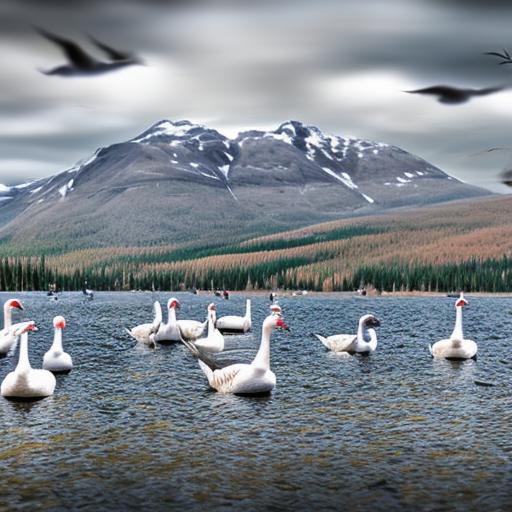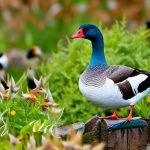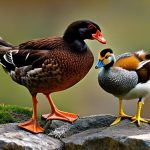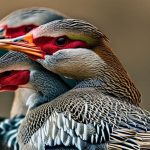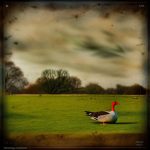The Canadian Goose, also known as the Canada Goose, is an iconic symbol of Canada and is widely recognized as a national symbol. These majestic birds are known for their distinctive black head and neck, white cheek patches, and brown body. They are often seen flying in a V-formation across the Canadian skies, making them a familiar sight to Canadians and visitors alike. The Canadian Goose holds a special place in the hearts of Canadians and is often associated with the country’s natural beauty and wildlife. Their presence in Canada’s parks, lakes, and rivers adds to the country’s natural charm and serves as a reminder of the importance of preserving the environment for future generations to enjoy.
The Canadian Goose has become a symbol of Canada’s natural heritage and is often featured in Canadian art, literature, and folklore. Their strong connection to the Canadian landscape has made them a beloved national symbol, and their image is often used to represent the country’s natural beauty and wildlife. The Canadian Goose has also become a popular subject for wildlife photographers and nature enthusiasts, who seek to capture the beauty and grace of these magnificent birds in their natural habitat. As a symbol of Canada’s natural heritage, the Canadian Goose serves as a reminder of the importance of preserving the country’s diverse ecosystems and wildlife for future generations to appreciate and enjoy.
The Different Breeds of Canadian Geese
There are several different breeds of Canadian Geese, each with its own unique characteristics and traits. The most common breed is the Giant Canada Goose, which is known for its large size and distinctive black head and neck. Another popular breed is the Lesser Canada Goose, which is smaller in size and has a lighter coloration than the Giant Canada Goose. There are also several subspecies of Canadian Geese, including the Cackling Goose, which is smaller in size and has a shorter neck than other breeds. Each breed and subspecies of Canadian Geese has its own unique physical characteristics and traits, making them a diverse and fascinating species to study and observe.
In addition to their physical differences, different breeds of Canadian Geese also have varying migration patterns and habitats. Some breeds are known to migrate long distances, while others prefer to stay in one location year-round. Understanding the different breeds of Canadian Geese is important for conservation efforts and wildlife management, as it allows researchers and conservationists to better understand the needs and behaviors of each breed in order to protect and preserve their populations for future generations to enjoy. By studying the different breeds of Canadian Geese, scientists can gain valuable insights into their behavior, ecology, and habitat requirements, which can help inform conservation strategies and management plans for these iconic birds.
Physical Characteristics and Traits of Canadian Geese
Canadian Geese are known for their distinctive physical characteristics, including their large size, long necks, and striking coloration. They have a wingspan of up to six feet and can weigh between 5-14 pounds, making them one of the largest species of geese in North America. Their plumage is typically brown with white underparts, and they have a black head and neck with white cheek patches. These physical characteristics make them easily recognizable and distinguishable from other species of geese.
In addition to their physical appearance, Canadian Geese are also known for their strong territorial instincts and protective nature. They are highly social birds that form strong bonds with their mates and offspring, often staying together in family groups throughout the year. They are also known for their loud honking calls, which they use to communicate with each other and establish their presence in their territory. Canadian Geese are also known for their strong migratory instincts, traveling long distances between their breeding and wintering grounds in search of food and suitable habitat. These physical characteristics and traits make Canadian Geese a fascinating species to study and observe in the wild, as they play an important role in Canada’s diverse ecosystems.
Behavioral Patterns and Migration Habits of Canadian Geese
Canadian Geese are known for their complex behavioral patterns and migration habits, which play a crucial role in their survival and reproduction. During the breeding season, Canadian Geese form monogamous pairs and build nests in a variety of habitats, including marshes, lakes, rivers, and grasslands. They are highly protective of their nesting sites and will aggressively defend them from potential threats, including predators and other geese. Once the eggs hatch, both parents take on the responsibility of caring for their young, teaching them how to forage for food and navigate their environment.
In addition to their breeding behavior, Canadian Geese are also known for their impressive migration habits, traveling thousands of miles between their breeding grounds in Canada and their wintering grounds in the southern United States. They typically migrate in large flocks, flying in a V-formation to conserve energy and take advantage of air currents. Their migration patterns are influenced by a variety of factors, including weather conditions, food availability, and habitat quality. Understanding the behavioral patterns and migration habits of Canadian Geese is important for conservation efforts, as it allows researchers and conservationists to identify key areas for protection and management to ensure the survival of these iconic birds.
Conservation Efforts for Canadian Geese
Conservation efforts for Canadian Geese are essential for protecting their populations and ensuring their long-term survival. Overhunting, habitat loss, pollution, and climate change have all had negative impacts on Canadian Geese populations, making it crucial to implement effective conservation strategies to protect these iconic birds. One of the most important conservation efforts for Canadian Geese is habitat protection and restoration, as it provides essential breeding, feeding, and resting areas for these birds throughout their annual life cycle.
In addition to habitat protection, conservation efforts for Canadian Geese also include population monitoring, research, education, and outreach programs to raise awareness about the importance of protecting these iconic birds. By studying their behavior, ecology, and habitat requirements, researchers can gain valuable insights into the needs of Canadian Geese populations and develop effective management plans to ensure their long-term survival. Conservation efforts for Canadian Geese also involve collaboration with government agencies, non-profit organizations, landowners, and local communities to implement sustainable management practices that benefit both wildlife and people.
The Role of Canadian Geese in Ecosystems
Canadian Geese play an important role in Canada’s diverse ecosystems as seed dispersers, grazers, and ecosystem engineers. As they forage for food in wetlands, grasslands, and agricultural fields, they help disperse seeds from plants that they consume, contributing to the diversity and regeneration of plant communities. Their grazing activities also help maintain open habitats by controlling vegetation growth, which benefits a variety of wildlife species that rely on these habitats for food and shelter.
In addition to their role as seed dispersers and grazers, Canadian Geese also contribute to nutrient cycling in ecosystems through their waste products. Their droppings contain valuable nutrients that enrich soil fertility and promote plant growth in wetlands and agricultural fields where they feed. This nutrient cycling process helps maintain the health and productivity of these habitats by supporting diverse plant communities that provide food and shelter for a variety of wildlife species. Understanding the role of Canadian Geese in ecosystems is important for conservation efforts, as it highlights the ecological importance of these iconic birds in maintaining the health and diversity of Canada’s natural landscapes.
Interactions and Relationships with Humans: Benefits and Challenges
The interactions and relationships between Canadian Geese and humans have both benefits and challenges that impact both wildlife conservation efforts and human communities. On one hand, Canadian Geese provide recreational opportunities for birdwatching enthusiasts, nature photographers, hunters, and wildlife enthusiasts who appreciate their beauty and grace in natural settings. Their presence in urban parks, lakes, rivers, and agricultural fields also offers opportunities for people to connect with nature and appreciate the importance of preserving wildlife habitats for future generations to enjoy.
On the other hand, interactions between Canadian Geese and humans can also pose challenges related to conflicts over habitat use, agricultural damage, human-wildlife conflicts, public health concerns related to waste products, and safety issues at airports due to bird strikes. These challenges require effective management strategies that balance the needs of both wildlife and people while minimizing negative impacts on both sides. By implementing sustainable management practices that promote coexistence between Canadian Geese and humans, it is possible to address these challenges while ensuring the long-term survival of these iconic birds.
In conclusion, the Canadian Goose is an iconic symbol of Canada that holds a special place in the hearts of Canadians as a national symbol representing the country’s natural beauty and wildlife heritage. Understanding the different breeds of Canadian Geese is important for conservation efforts as it allows researchers to better understand their behavior patterns which play a crucial role in their survival. Conservation efforts are essential for protecting these iconic birds from overhunting habitat loss pollution climate change among other threats they face today. The role of Canadian Geese in ecosystems is crucial as they contribute to seed dispersal nutrient cycling maintaining open habitats among other ecological functions that benefit both wildlife people alike. Interactions between Canadian Geese humans have both benefits challenges that impact both wildlife conservation efforts human communities requiring effective management strategies that promote coexistence between both parties while minimizing negative impacts on both sides.
Meet Walter, the feathered-friend fanatic of Florida! Nestled in the sunshine state, Walter struts through life with his feathered companions, clucking his way to happiness. With a coop that’s fancier than a five-star hotel, he’s the Don Juan of the chicken world. When he’s not teaching his hens to do the cha-cha, you’ll find him in a heated debate with his prized rooster, Sir Clucks-a-Lot. Walter’s poultry passion is no yolk; he’s the sunny-side-up guy you never knew you needed in your flock of friends!

